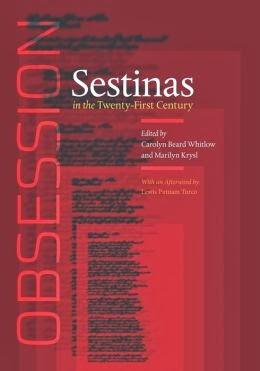 |
| Click Cover for Amazon |
I began with that first line and moved on to the next, then the next. I moved to the second stanza, putting the ending words down the right margin in the prescribed pattern. I labored hard. I stopped after a few stanzas. I put away the draft. I kept it nearby and often thought of it. Every few weeks or months I returned to it. Two years later that sestina was done. I’m not sure I have another one in me.
But I have dozens of them now before me, in the just-released anthology, Obsession: Sestinas in the Twenty-First Century, edited by Carolyn Beard Whitlow and Marilyn Krysl and published by UPNE. This is a beautifully designed book, with an elegant and eye-catching cover. I very much appreciate that the book is slightly over-sized so that each sestina fits on one page. The book includes 103 poems by 103 poets. I am happy to have my sestina included among poems by such poets as Maxine Kumin, Marilyn Nelson, Sherman Alexie, Alicia Ostriker, Kelly Cherry, Denise Duhamel, Patricia Smith, Dana Gioia, Donald Hall, and Evie Shockley. Space does not allow me to include all the names here, but trust me when I say that the list of poets is impressive.
The book is organized into eight sections: 1) Americana, 2) Art, 3) Love and Sex, 4) Memory, Contemplation, Retrospection, and Death, 5) The Natural World, 6) Sestinas about Sestinas: Metasestinas, 7) Sestinas with Irregular Teleutons, and 8) Unconventional Sestinas. The book begins with an excellent Introduction by Marilyn Krysl, includes a brief introduction before each section, and ends with an Afterword by Lewis Turco. Teachers and students of the sestina will be grateful to find an Index of First Lines, an Index of (Loosely) Metrical and Syllabic Sestinas, and an Index of Teleutons (each poem’s six repeating ending words).
Although all of the poems are in the same form, you’ll find plenty of variety here. The poems cover a wide range of topics. Some take liberties with the form and offer surprises. Some use short lines, some use long lines, some alternate line lengths, some use indented lines. Some of the poems include rhyme and some are metrical or syllabic. Some are serious while others are playful.
I'm enjoying this anthology so much that I'm beginning to think maybe I will try yet another sestina after all.
Here’s one of my favorites from the book. It’s by Kathryn Stripling Byer, former Poet Laureate of North Carolina.
Sleepless
It’s been years since I’ve kept a garden,
the soil needing too much work. One breath
of spring, and my old dread of late freeze
comes back again. Sometimes it’s moonlight
that keeps me awake. Sometimes night sweats.
Then I feel a clamor like wings
in my throat. The most frightening sound? Wings
in the chimney or trapped in the house. Such a garden
of fears I’ve grown all my life, sweaty
stalks rising out of the muck! When I couldn’t breathe
my mother would turn on the light
and sit rubbing my back. She spooned frozen
milk into my mouth, as if she’d freeze
the dark in my throat where those wings
trembled. The trouble with light?
There’s never enough at the end. I imagine a garden
the dying walk into as they take their last breath
before the gates slam shut. These sweaty
deathbed imaginings! What good does it do me to sweat
if I’ve nothing to show for it? If I could freeze
time, I’d never forget how each next breath’s
a mystery. What keeps it going, this wing-
beat of rise and fall, first thing that out of the garden
gate Adam and Eve saw, the cold light
of their own mortality dawning? God’s light
seemed thrilling at first. They were glad to sweat
under it, tilling the soil of that first garden,
expecting good weather to last, not a hard freeze
in store for eternity. The angels dozed, wings
furled all afternoon. So silent. Scarcely a breath.
Some days the wind makes me catch my breath.
Then I’m amazed by the simplest things—light,
for example, or air, the way it’s made for wings.
I remember my father at night washing sweaty
hands, dirt spinning round in the drain. He could freeze
me with one look, God turning me out of the garden.
That garden has always been breathing its myth
down my throat, its freezing light making my palms
sweat, my arms heavy with wanting to be wings.

It is an impressive book, and I am also published in it, with trembling delight! My sestina has the word "come" appear in a Fibonacci sequence--the first, second, third, fifth, eighth, thirteenth, etc word. Then, because I was having so much fun writing it, I wove the word "sing" backwards through the poem, using the Fibonacci sequence, as the last, second-to-last, third-to-last, etc. word. The words overlap at the second and second-to-last word, and so I switched them. There are a few other little interesting things that arose using this pattern, but that's the gist of it. It's kinda crazy, and I'm so happy to be in the collection.
ReplyDeleteStephanie--Your poem is just wonderful! I love it.
Delete